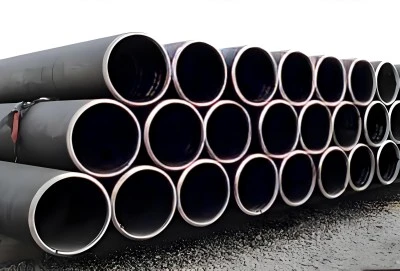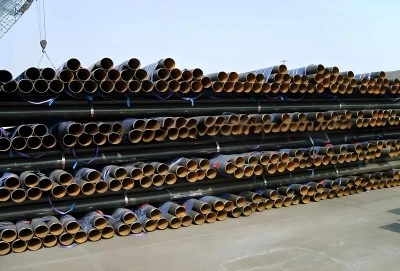In the world of oil and gas transportation, the choice of pipeline material is crucial for ensuring efficiency, safety, and longevity. API 5L X42 steel line pipe manufacturers are a popular choice for many applications, but when it comes to the manufacturing process, two methods stand out: Electric Resistance Welding (ERW) and Longitudinal Submerged Arc Welding (LSAW). As industry professionals seek the best solutions for their projects, understanding the differences between these two welding methods becomes essential. In this comprehensive guide, we'll explore the key differences between ERW and LSAW pipes, evaluate which welding method is better suited for X42 applications, and examine the cost implications of choosing one over the other.
|
|
|
What are the key differences between ERW and LSAW pipes?
ERW and LSAW pipes, while both used in the production of API 5L X42 steel line pipe manufacturers , have distinct characteristics that set them apart. Let's delve into the primary differences between these two pipe manufacturing methods:
Manufacturing Process: ERW pipes are created by rolling flat steel strips into a cylindrical shape and welding the seam using electric current to generate heat. This process is continuous and highly efficient, making it suitable for mass production. On the other hand, LSAW pipes are manufactured by first forming steel plates into a U-shape, then an O-shape, and finally welding the longitudinal seam using the submerged arc welding technique. This process allows for greater customization but is generally slower than ERW.
Pipe Diameter and Wall Thickness: ERW pipes are typically limited to smaller diameters, usually up to 24 inches, with wall thicknesses ranging from 4mm to 25mm. LSAW pipes, however, can be produced in much larger diameters, often exceeding 100 inches, with wall thicknesses up to 50mm or more. This makes LSAW pipes more suitable for high-pressure applications and large-scale projects.
Weld Strength and Quality: LSAW pipes generally have stronger welds due to the multi-pass welding process, which allows for better penetration and a more robust seam. ERW pipes, while still meeting industry standards, may have slightly lower weld strength due to the single-pass welding process. However, advancements in ERW technology have significantly improved weld quality in recent years.
Production Speed and Efficiency: ERW pipes can be produced at a much faster rate than LSAW pipes, making them more cost-effective for large-scale projects that require smaller diameter pipes. LSAW production is slower but offers more flexibility in terms of customization and larger sizes.
Material Utilization: ERW pipes typically have better material utilization, as they are produced from coiled steel strips with minimal waste. LSAW pipes, being made from steel plates, may have more material waste during the forming process.
Which welding method is better for X42 applications?
When it comes to choosing between ERW and LSAW for API 5L X42 steel line pipe manufacturers , the answer depends on the specific requirements of the project. Let's examine the factors that influence this decision:
Pressure Ratings: X42 grade steel is often used in moderate pressure applications. Both ERW and LSAW pipes can meet the pressure requirements for X42 grade, but LSAW pipes generally have an advantage in higher-pressure scenarios due to their thicker walls and stronger welds.
Pipe Diameter: If the project requires pipes with diameters larger than 24 inches, LSAW would be the preferred choice as ERW is limited in size. However, for smaller diameter pipes, ERW can be an excellent and cost-effective option.
Project Scale and Timeline: For large-scale projects with tight deadlines, ERW pipes might be more suitable due to their faster production rates. However, if the project requires custom sizes or has more flexible timelines, LSAW pipes could be a better fit.
Environmental Conditions: In harsh environments or where the pipeline may be subject to significant external pressures, LSAW pipes might be preferred due to their thicker walls and stronger welds. However, modern ERW pipes have improved significantly and can also perform well in many challenging conditions.
Quality Control: Both ERW and LSAW pipes undergo rigorous quality control processes. However, the multi-pass welding process of LSAW allows for more intermediate inspections, which can be advantageous in critical applications.
Ultimately, the choice between ERW and LSAW for X42 applications should be based on a careful evaluation of the project's specific requirements, including pressure ratings, pipe diameter, project scale, environmental conditions, and quality control needs.
How does cost differ between ERW and LSAW pipes?
Cost is often a significant factor in choosing between ERW and LSAW pipes for 5L X42 steel line pipe manufacturers. Several factors contribute to the overall cost difference:
Raw Material Costs: ERW pipes generally have lower raw material costs due to better material utilization. The use of steel coils in ERW production results in less waste compared to the steel plates used in LSAW production.
Production Efficiency: ERW pipes are produced at a faster rate, which translates to lower labor costs per unit. LSAW production is more labor-intensive and time-consuming, contributing to higher production costs.
Energy Consumption: The ERW process typically consumes less energy than the LSAW process, which requires multiple welding passes. This difference in energy consumption can impact the overall production cost.
Equipment Investment: ERW production lines generally require less capital investment compared to LSAW production facilities. This lower initial investment can result in more competitive pricing for ERW pipes.
Transportation Costs: For smaller diameter pipes, ERW can be more cost-effective to transport due to their lighter weight. However, for large-diameter pipes, LSAW may have an advantage as fewer pipe sections are needed to cover the same distance.
Maintenance and Inspection: LSAW pipes may have higher long-term costs associated with maintenance and inspection due to their more complex weld structure. ERW pipes, with their simpler weld design, may require less intensive maintenance over time.
While ERW pipes are generally more cost-effective for smaller diameter applications, the cost difference narrows as pipe diameters increase. For large-diameter pipes, LSAW may become more economical due to its ability to produce thicker-walled pipes with fewer joints over long distances.
It's important to note that while initial costs are a crucial consideration, the total cost of ownership should also be evaluated. This includes factors such as installation costs, maintenance requirements, and expected lifespan of the pipeline.
China API 5L X42 Steel Line Pipe Manufacturers
In the competitive landscape of API 5L X42 steel line pipe manufacturing, choosing the right supplier is crucial for project success. When selecting API 5L X42 steel line pipe manufacturers, it's essential to consider factors such as production capabilities, quality control measures, and certifications.
LONGMA GROUP stands out as a reputable manufacturer in this field. With their long-term stable cooperation with raw material factories and mature and complete production supporting facilities, they ensure consistent quality and reliability in their products. Their commitment to excellence is evident in their product certifications, including API 5L Certificate, ISO Certificate, and QMS Certificate.
If you are in the market for API 5L X42 steel line pipes and seeking a reliable manufacturer, LONGMA GROUP offers a compelling solution. Their expertise in both ERW and LSAW pipe production allows them to cater to a wide range of project requirements. To explore how LONGMA GROUP can meet your specific needs for API 5L X42 steel line pipes, don't hesitate to reach out to them at info@longma-group.com.














